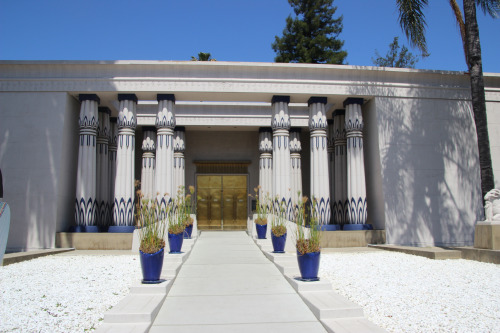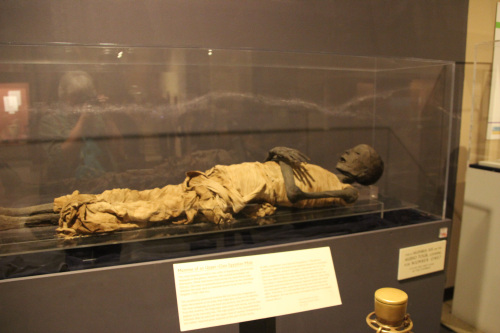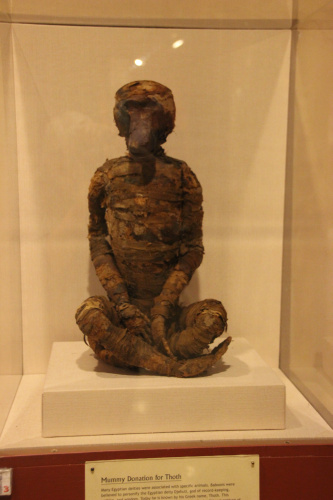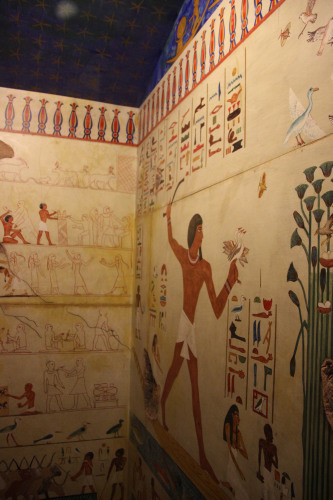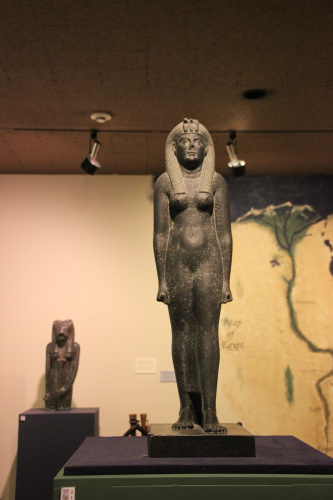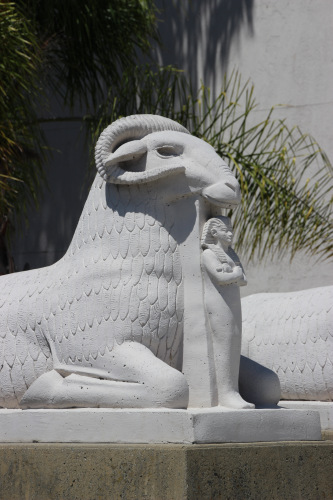The Nebula event offered tours of the Museum of Technology and the Rosicrucian Egyptian Museum. I chose the latter. Growing up in northern California I had heard about this museum. I had always assumed it would be vaguely campy, filled with Rosicrucian mysticism and quasi-historical replicas.
To my surprise, it is an elegant Egyptian museum with genuine artifacts. San Jose’s Rosicrucian Park and museum were founded in 1928 by H. Spencer Lewis, an explorer and mystic who was very interested in bringing the Rosicrucian movement back to the United States. Since the order funded expeditions at the turn of the twentieth century, they acquired many artifacts.
The Rosicrucian Park takes up one square city block in what is primarily a residential neighborhood in San Jose. It is right across the street from Herbert Hoover Middle School. The entrance is beautiful, with papyrus reeds planted in the dark blue planters, a touch of realism I appreciated.
The San Jose Museum has the largest collection of artifacts west of the Mississippi river, including a couple of human mummies. One of the adult male mummies was on display. I was flooded with thoughts and emotions while I looked at this. The information provided by the museum on the process and some of the scientific tests was excellent; I kept looking at it, thinking it was so slender it looked like a effigy; I kept thinking that a few thousand years earlier this was a person, a guy. He had a family, he had a job, he had dreams; he had good friends and bad days. I don’t think his belief-system had a place for the concept that his preserved body would repose in a temperature controlled pace in an air-conditioned building, for the edification and entertainment of tourists, for eternity.
I was amazed how many animals were mummified to be included in tombs – and how “quick and dirty” some of those mummifications were (like dipping falcon corpses in a pitch mixture). The baboon mummy was poignant, reminding me of my tendency to anthropomorphize everything. Apparently, I’m not the only one with that impulse. Either that, or the cheesy 1980s vintage Sinbad movie that starred a young Jane Seymour as a princess whose brother the prince was turned into a baboon had a deeper impact on me that I expected. That would be really sad.
Rebecca, our docent, gave us a tour of the replica tomb that is carved out underneath the museum. Rebecca was well-prepared as a tour guide with a nice sense of humor. She limited her comments about the Rosicrucians, who founded the place, to one sentence, and focused mostly on the facts of the tombs and Egyptian funerary customs. Here is the Wikipedia site for the order, if you are interested.
The Egyptians took seventy days to embalm a body, which meant seventy days was just how much time the artisans had to paint the life story of the deceased on the walls of the tomb. She also told us that the odd arm positions and stances of the deceased (always in profile) were chosen so that every aspect of the body would be transferred into the afterlife. How embarrassing if an important appendage was missing because the artist didn’t show it!
The museum permits and even encourages photography as long as no flash is used, because the UV light from the flash can damage some of the more fragile artifacts, particularly some of the papryrii they have, that still show the writing.
Behind Cleopatra is a statue of Sekhmet
The other galleries are devoted to daily life in Egypt; one to Sekhmet and one to the monotheist Pharaoh Akhenaten. Rebecca was particularly proud of a period statue of Cleopatra – yes, that Cleopatra. She is shown in a traditional Egyptian pose but the Roman influence is still plain. My favorite artifact was a shallow stone disc, the size of the palm of my hand, filled with holes. It looked like a small colander; in fact, it was a beer strainer. Egyptian beer was so thick… er, full-bodied, that it needed to be strained before it was drunk.
The museum needs more than one trip to be appreciated. After a few hours, I was overwhelmed. There were fascinating things I didn’t pay enough attention to, such as the royal rings in the collection and the elaborate cylindrical seals the bureaucrats used, and some things I’m sure I skimmed over just because there is so much to see.
For anyone in the San Francisco Bay Area or planning a trip here, the museum is a worthwhile day trip in its own right. For anyone planning to write Egypt-based fantasy, this is a valuable resource. I think I need another trip, just to take everything in.

